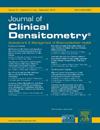利用胸片双重检测股骨颈和腰椎低骨密度的AI模型的开发
IF 1.6
4区 医学
Q4 ENDOCRINOLOGY & METABOLISM
引用次数: 0
摘要
人工智能(AI)技术在胸部x线片上检测整体骨质疏松症的准确性很高,为快速和容易获得的骨质疏松症筛查提供了巨大的潜力。然而,由于骨质流失因生活方式和体型而异,检测特定部位的低骨密度(BMD)对于早期治疗至关重要。本研究开发并评估了两种深度学习模型,用于检测股骨颈和腰椎的低骨密度。方法:资料包括2,728名女性体检者的胸片和双能x线骨密度仪(DXA)测量的骨密度值[g/cm2]。胸片根据股骨颈(低:1358,正常:1370)和腰椎(低:562,正常:2166)分为低骨密度或正常。深度学习模型使用ResNet50架构进行训练,并进行微调和10倍交叉验证。性能指标包括灵敏度、特异性、总体准确度和曲线下面积(AUC)。使用可解释的人工智能生成的与低骨密度相关的可视化区域热图。结果:该模型对股骨颈检测的总准确率为75.3 % (AUC: 0.82),腰椎检测的总准确率为89.3% % (AUC: 0.96)。腰椎检测的准确率比股骨颈高14.0 %。腰椎骨密度低的患者比单纯股骨颈骨密度低的患者表现出更严重的骨质流失。热图显示锁骨和胸椎附近的相关区域。结论:该模型能准确地检测胸片中的低骨密度,并识别骨质流失区域,在腰椎检测方面表现出特别高的性能。早期发现低骨密度可以简单、有效地进行筛查,并根据骨质流失的区域进行针对性的预防或治疗。本文章由计算机程序翻译,如有差异,请以英文原文为准。
Development of AI model for dual detection of low bone mineral density in the femoral neck and lumbar vertebrae using chest radiographs
Introduction: Artificial intelligence (AI) technologies have demonstrated high accuracy in detecting overall osteoporosis on chest radiographs, offering significant potential for rapid and accessible osteoporosis screening. However, as bone loss varies by lifestyle and body shape, detecting low bone mineral density (BMD) in specific parts is crucial for early treatment. This study developed and evaluated two deep learning models to detect low BMD in the femoral neck and lumbar vertebrae.
Methods: Data included chest radiographs and dual-energy X-ray absorptiometry (DXA)-measured BMD values [g/cm2] of 2,728 female examinees. Chest radiographs were categorized into low BMD or normal based on the femoral neck (low: 1,358, normal: 1,370) and lumbar vertebrae (low: 562, normal: 2,166). Deep learning models were trained using the ResNet50 architecture with fine-tuning and 10-fold cross-validation. Performance metrics included sensitivity, specificity, overall accuracy, and area under the curve (AUC). Heatmaps generated using Explainable AI visualized regions related to low BMD.
Results: The model achieved 75.3 % overall accuracy (AUC: 0.82) for femoral neck detection and 89.3 % (AUC: 0.96) for lumbar vertebrae detection. Lumbar vertebrae detection showed 14.0 % higher accuracy than the femoral neck. Patients with lumbar vertebrae low BMD exhibited more advanced bone loss compared to those with femoral neck low BMD alone. Heatmaps indicated relevant regions near the clavicle and thoracic vertebrae.
Conclusion: The proposed model accurately detected low BMD in chest radiographs and identified areas of bone loss, demonstrating particularly high performance in lumbar vertebrae detection. Early identification of low BMD enables simple, effective screening and targeted prevention or treatment based on areas of bone loss.
求助全文
通过发布文献求助,成功后即可免费获取论文全文。
去求助
来源期刊

Journal of Clinical Densitometry
医学-内分泌学与代谢
CiteScore
4.90
自引率
8.00%
发文量
92
审稿时长
90 days
期刊介绍:
The Journal is committed to serving ISCD''s mission - the education of heterogenous physician specialties and technologists who are involved in the clinical assessment of skeletal health. The focus of JCD is bone mass measurement, including epidemiology of bone mass, how drugs and diseases alter bone mass, new techniques and quality assurance in bone mass imaging technologies, and bone mass health/economics.
Combining high quality research and review articles with sound, practice-oriented advice, JCD meets the diverse diagnostic and management needs of radiologists, endocrinologists, nephrologists, rheumatologists, gynecologists, family physicians, internists, and technologists whose patients require diagnostic clinical densitometry for therapeutic management.
 求助内容:
求助内容: 应助结果提醒方式:
应助结果提醒方式:


